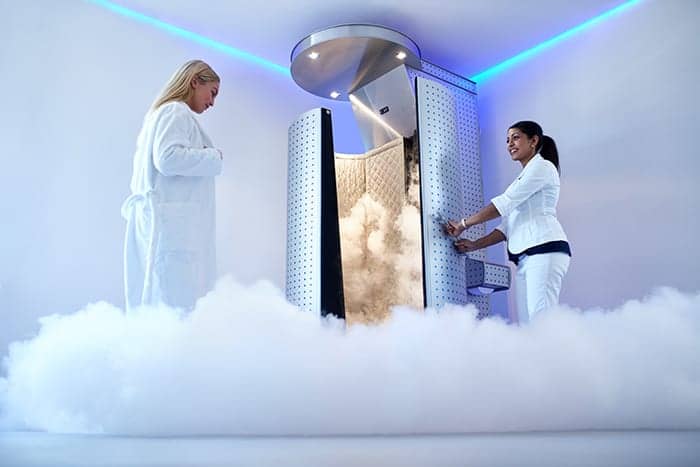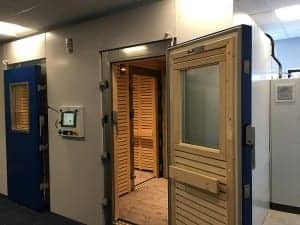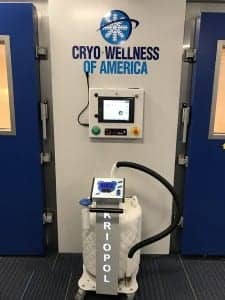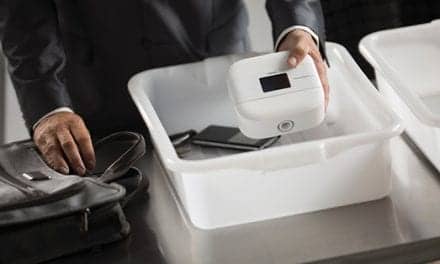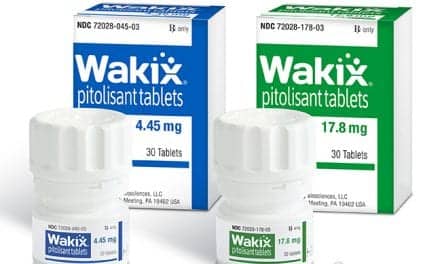A study examines the potential benefits of whole-body cryotherapy on improving sleep quality and duration.
Sleep physicians rely on an ever-increasing array of techniques and tools to help their patients sleep better and improve their overall health. A new tool being investigated by a physician in Buffalo, NY, is cryotherapy, also known as cold therapy, which may offer sleep physicians a way to help patients struggling with issues of restlessness or wakefulness.
The study is being conducted in conjunction with Cryo-Wellness of America LLC, which is located in the Buffalo suburb of Depew.
Whole-body cryotherapy (as opposed to localized cryotherapy) was developed in Japan by Dr Toshiro Yamauchi in the 1970s to treat rheumatoid arthritis. Since then whole-body cryotherapy has been used to alleviate inflammation, arthritic pain, and fibromyalgia-related pain. European studies have also identified whole-body cryotherapy as effective in reducing spasticity in neurological diseases,1 as a method of kinesiotherapy in rheumatic diseases2 and multiple sclerosis,3 and for its sedative effect in patients with psoriasis and neurodermatitis.4
And there is anecdotal evidence that it has improved sleep.
A Confluence of Serendipitous Events
While benefits of whole-body cryotherapy have been documented in Japan and Europe, Robert Fronckowiak, president of Cryo-Wellness of America, was skeptical of using cold therapy to treat his frozen shoulder during an extended stay in Krakow, Poland, in 2013. But, after 10 three-minute treatments, he saw marked improvement in his ability to move his shoulder.
“I have to admit that walking into the chamber for the very first time was pretty scary,” he recalls. “I wasn’t sure I would be able to withstand the cold. I was surprised to discover that the cold was very tolerable because it is a dry cold without wind. Not only did the treatments help my shoulder, but they also substantially reduced overall body aches and pains. I felt a sense of regeneration after each treatment and began to look forward to subsequent treatments with enthusiasm.”
Not only did Fronckowiak see improvements in his own health, but he saw an opportunity. And in February 2018, Cryo-Wellness of America opened its doors.
The 3,000-sq-ft facility houses two cryo-chambers, a pre-chamber measuring 6-ft by 7.5-ft and the main chamber measuring 6.5-ft by 7.5-ft. The pre-chamber is kept at -60 degrees Fahrenheit and the main chamber is kept at -184 degrees Fahrenheit, cooled by a steady stream of nitrogen.
An initial visit to the chamber can be daunting—not surprisingly, participants must cover their mouth, nose, and ears, with a mask and stocking cap. Gloves are a must, but counterintuitively, patients typically wear shorts and a T-shirt, the feet and lower legs covered by knee socks and wooden clogs (the latter to avoid slipping or sticking to the floor). However, it’s recommended that male users go shirtless and female users wear a sports bra—if they feel they can tolerate the cold—since they’ll get more benefit from having more torso exposed.
Users enter the pre-chamber for 30 seconds, to get acclimated to the cold; when the 30 seconds are up, they move into the main chamber for up to 3 minutes. During the entire process, a member of the Cryo-Wellness medical team monitors the participants, marking time, and making sure they are having no difficulties. Users can leave the chamber at any time if they are feeling unwell or for any other reason.
“Potential users are forewarned that if they have a fear of cold or small spaces, the cryo-chamber might be contraindicated,” explains James Kenney, EdD, vice president of operations and research for Cryo-Wellness of America. “When using the chamber for the first time, they are offered the option of being accompanied by a staff member.”
Users exit the chamber in a dramatic cloud of nitrogen-cooled fog and are immediately evaluated by medical staff who take the surface temperature of their skin. Participants then move to another room where they warm up on stationary bicycles.
While users are monitored throughout the process, prior to using the cryo-chamber, they must complete a health evaluation, according to Kenney. Among the contraindications are heart-related issues (including a recent heart attack), pregnancy, seizure disorders, open wounds, or having alcohol in your system.
Even with screening and monitoring procedures in place, there can be mild side effects to the procedure, according to Kenney. “Some participants have reports red marks on their skin, also known as ‘cryo burn.’ They are treated with topical cream and fade after a couple of days,” he says.
The overwhelming reason patients have come to Cryo-Wellness of America is to reduce pain from athletic injuries/participation or from chronic medical conditions.
The connection to whole-body cryotherapy as a treatment for sleep disorders was another bit of serendipity for Fronckowiak.
His sister-in-law Peggy, who had a history of restless sleep, noticed a change in her sleep patterns after using the chamber, which she was able to monitor with her Fitbit. Kenney, intrigued, asked her for the data prior to using the chamber and after, and the results were startling.
During a 21-day period, correcting for a period when she was ill, Kenney’s analysis found that her times awake dropped 42.1% and times restless dropped 18.8%. Her combined times awake/restless dropped 22.6%.
Kenney shared his analysis with Jennifer Scheid, PhD, CSCS, assistant professor in the health promotion program at Daemen College, in nearby Amherst, NY. Her interest was piqued about what Kenney’s analysis indicated.
At the same time Kenney found out that, according to CDC data, Buffalo was one of the regions in the country where 43.2% of the population was getting less than 7 hours of sleep per night, compared to the national average of 35%.5
Scheid agreed that a pilot study on the potential benefits of whole-body cryotherapy on sleep was warranted.
Testing a Hypothesis
Scheid’s pilot study, entitled “Whole-body Cryotherapy: Case Series of Sleep, Pain and Anxiety in Healthy Individuals,” is designed to test the impact of 10 cryotherapy sessions on several parameters. “The hypothesis is that 10 whole-body cryotherapy sessions will have a positive impact on sleep, pain levels, and anxiety in otherwise healthy individuals,” she says.
The longitudinal study involved five subjects—one male and four females ranging in age from 52 to 74. Surveys related to sleep, pain, and anxiety levels were administered prior to and after the 10 WCBT sessions. The subjects received their sessions at Cryo-Wellness of America. Sleep was assessed using the Pittsburg Sleep Quality Assessment Index (PSQI), pain was measured using the Borg Rate of Perceived Pain Scale, and anxiety was assessed using the Hamilton Anxiety Scale. Participants were chosen from a pool of individuals who signed up for 10 WCBT sessions.
Scheid, who handled all of the data analysis for the pilot study, will be presenting her initial findings at the American College of Sport Medicine (ACSM)’s annual conference in Orlando in May during session C-40, which is on May 30 from 7:30 am to 12:30 pm (the specific presentation time is 9:30 am to 11 am).
According to the abstract for her discussion, which will be published in Medicine and Science in Sports and Exercise, Volume 51:5 Supplement, only a single patient—one who had self-reported sleep issues—saw improvement in her sleep patterns. The others saw improvements in their level of pain. Two patients who reported no sleep, pain, or anxiety issues, saw no changes in their health. The sample size was too small to draw broad conclusions, but the now-proven recruitment and data analysis capabilities of Cryo-Wellness of America offer optimism for a potentially larger-scale research project on whole-body cryotherapy and sleep.
The Next Step
“I think there are possible uses for whole-body cryotherapy to help with sleep, pain, and anxiety,” she says. “However, currently we are at the very early stages of the research process. Right now we are trying to see if clients at Cryo-Wellness of America are seeing positive results and if we can measure these changes. The next step, if our current pilot study is successful, will be to design a randomized control trial to see if whole-body cryotherapy can improve sleep quality, etc.”
Another possible barrier to using whole-body cryotherapy as a tool to treat sleep disorders is that the US Food and Drug Administration has not cleared it as a medical device. In fact, the Cryo-Wellness of America’s chamber—which was shipped from Poland via Canada—is designated as a non-medical device.
Scheid’s pilot study may be the first step needed to lead to eventual FDA clearance.
During his research for this article, Sleep Review contributing writer C.A. Wolski took part in a couple of cryotherapy sessions—not only did he feel better, but he got one of the best night’s sleep in several months according to his Fitbit.
References
1. Miller E, K?dziora J. Effect of whole body cryotherapy on uric acid concentration in plasma of multiple sclerosis patients. International Review of Allergology and Clinical Immunology. 2011;17:20-3.
2. Stanek A, Cholewka A, Gadula J, et al. Can whole-body cryotherapy with subsequent kinesiotherapy procedures in closed type cryogenic chamber improve BASDAI, BASFI, and some spine mobility parameters and decrease pain intensity in patients with ankylosing spondylitis? Biomed Res Int. 2015;2015:404259.
3. Miller E, Mrowicka M, Malinowska K, et al. Effects of whole-body cryotherapy on a total antioxidative status and activities of antioxidative enzymes in blood of depressive multiple sclerosis patients. World J Biol Psychiatry. 2011 Apr;12(3):223-7.
4. Klimenko T, Ahvenainen S, Karvonen SL. Whole-body cryotherapy in atopic dermatitis. Arch Dermatol. 2008 Jun;144(6):806-8.
5. CDC. Short sleep duration among US adults. 2017 May 2. National Center for Chronic Disease Prevention and Health Promotion, Division of Population Health. Available at www.cdc.gov/sleep/data_statistics.html.

